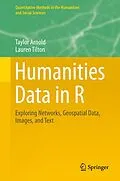This pioneering book teaches readers to use R within four core analytical areas applicable to the Humanities: networks, text, geospatial data, and images. This book is also designed to be a bridge: between quantitative and qualitative methods, individual and collaborative work, and the humanities and social scientists. Exploring Humanities Data Types with R does not presuppose background programming experience. Early chapters take readers from R set-up to exploratory data analysis (continuous and categorical data, multivariate analysis, and advanced graphics with emphasis on aesthetics and facility). Everything is hands-on: networks are explained using U.S. Supreme Court opinions, and low-level NLP methods are applied to short stories by Sir Arthur Conan Doyle. The book's data, code, appendix with 100 basic programming exercises and solutions, and dedicated website are valuable resources for readers. The methodology will have wide application in classrooms and self-study for the humanities, but also for use in linguistics, anthropology, and political science. Outside the classroom, this intersection of humanities and computing is particularly relevant for research and new modes of dissemination across archives, museums and libraries.
Autorentext
Taylor Arnold is Senior Scientist at AT&T Labs Research and Lecturer of Statistics at Yale University. His research focuses on statistical computing, numerical linear algebra, and machine learning. He is the technical director of Photogrammar (photogrammar.yale.edu).
Lauren Tilton is a doctoral candidate in American Studies at Yale University. Her interests include documentary media, 20th century history, and visual culture. She is an active member of the digital humanities community, serving as the humanities director of Photogrammar and co-Principal Investigator of the Participatory Media project.
Inhalt
Set-up.- A Short Introduction to R.- EDA I Continuous and Categorical Data.- EDA II Multivariate Analysis.- EDA III Advanced Graphics.- Networks.- Geospatial Data.- Image Data.- Natural Language Processing.- Text Analysis.- Appendix.
